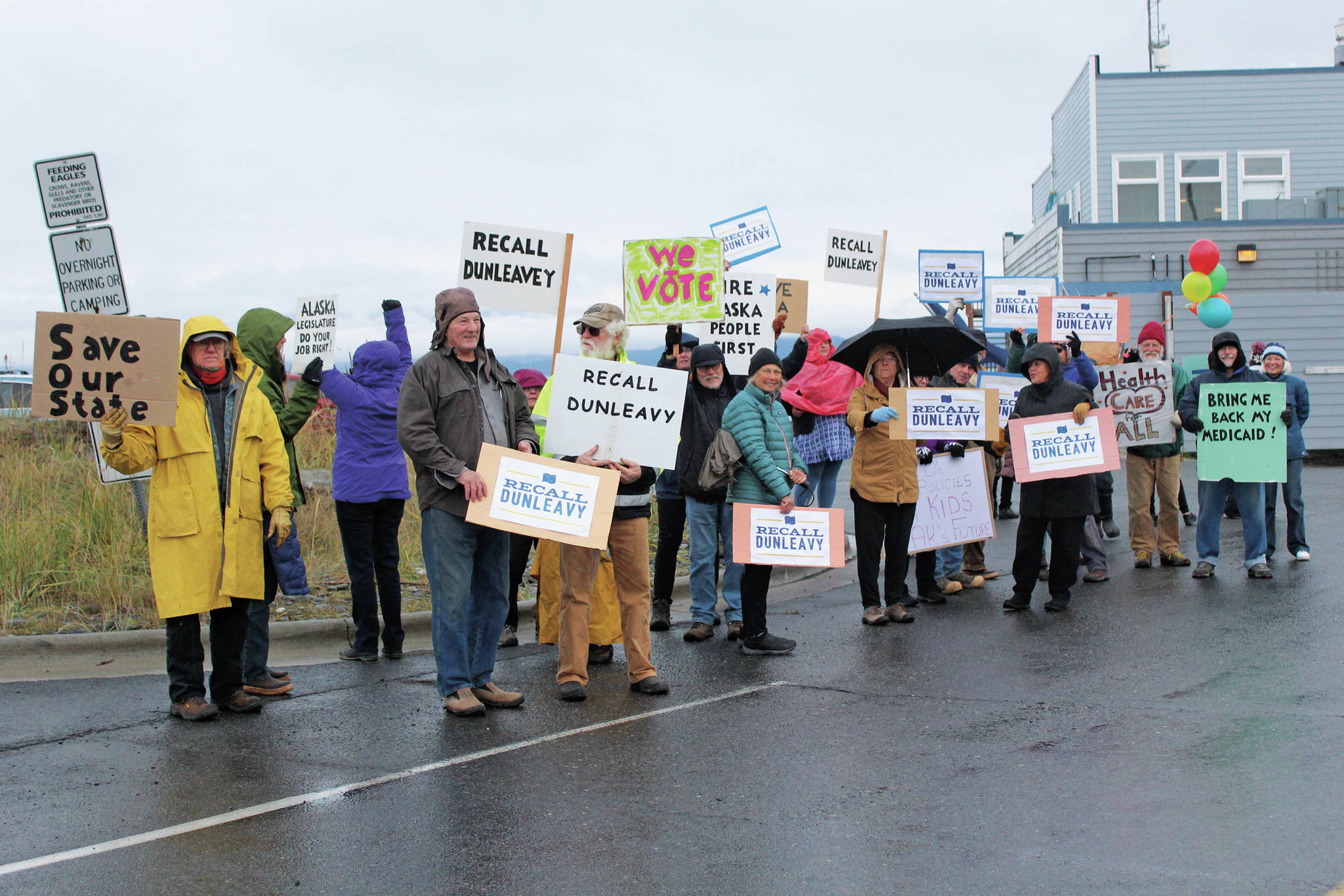Gov. Mike Dunleavy told home builders from around the state that Alaska has plenty of development potential yet to be realized, while outside, a handful of supporters of the Recall Dunleavy effort gathered to protest.
Dunleavy briefly visited a conference held Wednesday through Friday by the Alaska State Home Building Association and the Kenai Peninsula Home Builders Association at Land’s End Resort in Homer. He gave an update on the statewide economy and answered questions about the next budget cycle, the Permanent Fund Dividend and what his administration is or isn’t doing to capitalize on certain kinds of energy in the state.
During his address, a group of local supporters of the statewide campaign to recall Dunleavy gathered outside Land’s End with signs reading “Save our state,” “Recall Dunleavy” and “Hire Alaska people first.”
In the conference, Dunleavy praise the Ted Stevens Anchorage International Airport for being the “second busiest cargo airport in the country” and talked about planned expansions to that facility in the form of two “trans shipment warehouses for overseas cargo.”
“You probably saw in the paper here the other day where President Trump has lifted the roadless rule in the Tongass (National) Forest so that we could potentially get a timber industry going back down in Southeast Alaska,” Dunleavy said.
Dunleavy said his administration is continuing to look at state regulations to determine whether they are necessary for the health and safety of Alaskans, or whether they are “unnecessary and getting in the way of business.”
Alaska has the infrastructure to transport its resources and services, Dunleavy said. What it boils down to, he said, is whether the people of Alaska want to capitalize on the state’s development opportunities going forward or not.
“The question going forward will be, what will the politics be, not just in this country, but here in Alaska?” he said. “Will the politics stay the same in the sense that we still look upon resource development and resource transportation as something that Alaska does well, or will we start to go the way of some other states down south … will we start to reflect that here in Alaska where we don’t want to develop and we want to close things off? And we basically end up in some respects being a large national park?”
At the same time, Dunleavy acknowledged the shortfall of having a state budget so reliant on one major resource: oil. When asked by a conference attendee about the next budget cycle, Dunleavy described how his administration worked on the budget last year based on the projected cost of a barrel of oil.
“A year ago October 10, oil was at $85 a barrel … and the projection was it was going to go higher,” he said. “So at that stage of the game, we were looking at taking the next year or two and doing a slight, smaller step down in the budget. By December 28, I believe, it was at $54 a barrel, and they were predicting it would go lower. So that’s why we came in with a budget that had a lot of reductions in it, because we’re trying to balance the budget based upon oil, which is … it’s a terrific discussion as to how long we can keep going by just having one leg on our stool to support the government.”
Several conference attendees asked Dunleavy whether his administration is doing anything to encourage or explore other energy sources in the state, such as solar, wind, tidal and geothermal.
“I’m looking right across the inlet as far as geothermal, tidal energy,” one conference attendee said. “Because of the cost of everything, and the limitations, I think we need to invite companies who are doing it. United Kingdom is doing it … Hawaii’s doing it on Big Island.”
Dunleavy said his administration would “welcome” conversations about how to make those energy sources cost effective and affordable for Alaskans. He also said his administration is not discounting them, but did not give any examples of the state actively pursuing them from a policy standpoint.
“If I was in this office for a few more years, that would be one of the things I think, if I was able to accomplish that, that would be one of the hallmarks of this administration, would be to be able to get a lower cost energy to Alaskans right here,” Dunleavy said. “And some of those sources that you just mentioned would be part of that.”
Reach Megan Pacer at mpacer@homernews.com.


